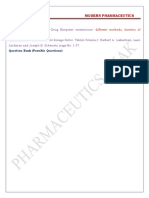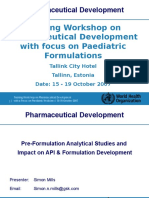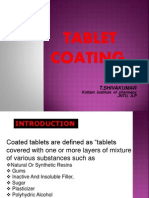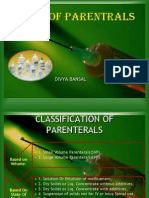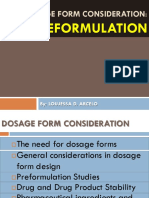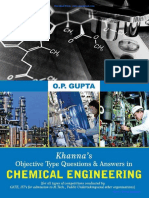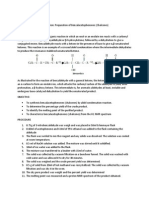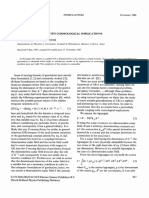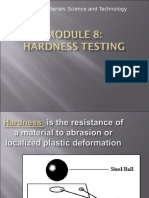Preformulation Studies
Preformulation Studies
Uploaded by
Hanuma KanthetiCopyright:
Available Formats
Preformulation Studies
Preformulation Studies
Uploaded by
Hanuma KanthetiOriginal Description:
Copyright
Available Formats
Share this document
Did you find this document useful?
Is this content inappropriate?
Copyright:
Available Formats
Preformulation Studies
Preformulation Studies
Uploaded by
Hanuma KanthetiCopyright:
Available Formats
See discussions, stats, and author profiles for this publication at: https://www.researchgate.
net/publication/322910385
Pharmaceutical preformulation studies in formulation and development of
new dosage form: A review
Article · February 2018
CITATION READS
1 3,953
1 author:
Manoj Mishra
Shambhunath Institute of Pharmacy, Allahabad, India
65 PUBLICATIONS 63 CITATIONS
SEE PROFILE
All content following this page was uploaded by Manoj Mishra on 03 February 2018.
The user has requested enhancement of the downloaded file.
International Journal of Pharma Research & Review, Oct 2016;5(10):12-20 ISSN: 2278-6074
Review Article
Pharmaceutical Preformulation Studies in Formulation and Development of New
Dosage Form: A Review
Garima Verma*, Manoj Kumar Mishra
Shambhunath Institute of Pharmacy, Jhalwa, Allahabad, Uttar Pradesh-211012, India.
_______________________________________________________________________________________________________________________
Abstract:
Preformulation commences when a newly synthesized drug shows sufficient pharmacologic
promise in animal models to warrant evaluation in man. These studies should focus on those
physicochemical properties of the new compound that could affect drug performance and
development of an efficacious dosage form. A thorough understanding of these properties may
ultimately provide a rational for formulation design or support the need for molecular
modification. This review article focus on the various preformulation factors which effect the
development of new dosage form like drug solubility, partition coefficient, dissolution rate,
polymorphic forms and stability. Every drug has intrinsic chemical and physical properties
which has been consider before development of pharmaceutical formulation. This property
provides the framework for drug’s combination with pharmaceutical ingredients.
Preformulation studies carried out by various research scientists are reviewed. Preformulation
studies conduct for newly synthesized compounds or extracted compound and it gives the
information regarding the degradation process, any adverse conditions relevant to the drug,
bioavailability, pharmacokinetics and formulation of similar compound and toxicity.
Preformulation studies strengthen the scientific foundation of the guidance, provide regulatory
relief and conserve resources in the drug development and evaluation process, improve public
safety standards, enhance product quality in the fabrication of dosage form. Objective of
preformulation study is to develop the elegant, stable, effective and safe dosage form by
establishing kinetic rate profile, compatibility with the other ingredients and establish Physico-
chemical parameter of new drug substances. Polymorphism having crystal and amorphous
forms shows different chemical physical and therapeutic description of the drug molecule.
Keywords: Preformulation, partition coefficient, dissolution rate, polymorphic
Received 06 Sept 2016 Received in revised form 21 Sept 2016 Accepted 23 Sept 2016
Corresponding Author:
Garima Verma,
Shambhunath Institute of Pharmacy, Jhalwa, Allahabad, Uttar Pradesh-211012, India.
Email: garima.srivastava2111@gmail.com, bmanojmishra@gmail.com
_________________________________________________________________________________________________________________________
INTRODUCTION
Before starting the preformulation studies, team consisting of representatives from the
we should know the properties of the drug, disciplines has responsibility for assuring
potency relative to the competitive that the compound enters the development
products and the dosage form, literature process in its optimum molecular form.
search providing stability and decay data, When the first quality sample of new drug
the proposed route of drug administration, becomes available, probing experiments
literature search regarding the formulation should be conducted to determine the
approaches, bioavailability and magnitude of each suspected problem area.
pharmacokinetics of chemically related If a deficiency is detected the project team
drugs. should decide on the molecular
Once a pharmacologically active modifications that would most likely
compounds has been identified, a project improves the drug properties. Salts,
Garima Verma et.al, IJPRR 2016;5(10) 12
International Journal of Pharma Research & Review, Oct 2016;5(10):12-20 ISSN: 2278-6074
prodrugs, solvates, polymorphs or even interesting for drug developers because
new analogs may emerge from these their thermodynamic and physicochemical
modification efforts. The major areas of properties, such as melting point, density,
preformulation research are following- stability and in particular solubility, may
1. Bulk Characterization offer an improvement on the original form.
Crystallinity and polymorphism Generally, the solubility of metastable
Hygroscopicity polymorphs is kinetically higher than that
Particle size of a thermodynamically more stable
Bulk density polymorph [5], offering, at least in theory, a
Powder flow properties solution to bioavailability problems.
2. Solubility Analysis Actually, it has been demonstrated that
Ionization constant-pKa differences between the solubility of one
pH solubility profile polymorph and another are typically lower
Common Ion Effect-Ksp than a factor of two [6] or more rarely of
Thermal Effects five [7]. Thus, while a polymorph may offer
Solubilization a slight improvement in solubility
Partition Coefficient compared to the original compound, this
Dissolution benefit may be offset the fact that it is also
3. Stability Analysis less stable than the original, and thus there
Stability in Formulations may be no advantage in choosing this
Solution Stability polymorph over the original compound.
pH Rate Profile Actually, metastable and more soluble
Solid State Stability forms tend to convert into the more
Bulk Stability thermodynamic stable form in a relatively
Compatibility short time.
Bulk characterization- A drug candidate at The presence of specific excipients, or
this stage had not all of its solid forms particular chemical and/or technological
identified, and there is a great potential for processes may accelerate the transition to
new polymorphs to emerge. Bulk properties the solid state [8, 9]. This transition may
for the solid forms such as particle size, proceed according to the relative
bulk density and surface morphology are thermodynamic stability of metastable
also likely to change during process forms.
development. Solvates, also inappropriately termed
Crystallinity and polymorphism: Elements pseudopolymorphs [10], are crystalline
can exist in two or more different forms, solids containing within the crystal
known as allotropes of that element e.g. structure either stoichiometric or
Carbon: diamond in cubic (tetrahedral nonstoichiometric proportions of solvent.
lattice arrangement) graphite in sheets of a When the incorporated solvent is water, the
hexagonal lattice. Polymorphs show the solvate is called a hydrate. In general, it is
same properties in the liquid or gaseous undesirable to use solvates for drugs and
state but they behave differently in the solid pharmaceuticals, as the presence of organic
state. Different polymorphs of a compound solvent residues may be toxic; regulations
are in general different in structure and for all the organic solvents in products for
properties in the same manner as the human use establish specific limits to how
crystals of two different compounds. much daily exposure to residual solvent in
Furthermore polymorphism is remarkably the formulated preparation is allowed. The
common particularly within certain solubility and dissolution rate of a drug can
structural groups. significantly differ for different solvates,
The phenomenon of polymorphism is quite and in particular hydrates [11].
common among organic molecules, and Hydrates may have a faster or slower
many drugs can crystallize into different dissolution rate than the corresponding
polymorphic forms [1-4]. Molecules anhydrous form, though more frequently,
Polymorphic forms of drugs can prove the former are slower than the latter [12],
Garima Verma et.al, IJPRR 2016;5(10) 13
International Journal of Pharma Research & Review, Oct 2016;5(10):12-20 ISSN: 2278-6074
perhaps because there are fewer sites of the crystalline solvates are formed. Pseudo-
drug molecule available for interaction with polymorphs can be differentiated from true
water during dissolution. A classic example polymorphs by observing melting behavior
is theophylline anhydrate, which dissolves in silicon oil using hot stage microscopy.
faster than its hydrate form [13,14]. In Here in this technique pseudo polymorphs
other cases, the hydrate form exhibits a evolve gas (steam or solvent vapors)
more rapid dissolution rate than its causing bubbling of the oil. While true
anhydrous form: for example, erythromycin polymorphs merely melts, forming second
dihydrate was found to exhibit a globular phase.
significantly faster dissolution rate than Hygroscopicity- Many drug substances,
that of monohydrate and anhydrous forms particularly water soluble salt forms have a
[15,16]. tendency to adsorb atmospheric moisture.
Glibenclamide has been isolated as pentanol Adsorption and equilibrium moisture
and toluene solvates, and these solvates content can depend upon the atmospheric
exhibited higher solubility and dissolution humidity, temperature, surface area,
rate than two non-solvated polymorphs exposure and mechanism for moisture
[17]. The physical stability of hydrates and uptake [22]. Deliquescent materials adsorb
anhydrous forms strongly depends upon sufficient water to dissolve completely, as is
the relative humidity and/or temperature observed with sodium chloride on a humid
of the environment [18-20], and transitions day. Other hygroscopic substances adsorb
from one form to the other occur as a water because of hydrate formation or
consequence of variations in storage specific site absorption. With most
conditions and/or technological treatments hygroscopic material, changes in moisture
[21]. In particular, anhydrous to hydrate level can greatly influence many important
transitions can occur during dissolution at parameters, such as chemical stability,
the drug/medium interface and can affect flowability and compatibility.
dissolution rate and perhaps bioavailability To test for hygroscopicity, samples of bulk
[18]. drug are placed in open containers with a
Type of Polymorphism- There are two thin powder bed to assure maximum
types of polymorphs- enantiotropic atmospheric exposure. These samples are
polymorphs and monotropic polymorphs. then exposed to arrange of controlled
ENANTIOTROPHS: - If one form stable over relative humidity environment prepared
certain pressure and temperature range, with saturated aqueous salt solutions [23].
while the other polymorph is stable over Moisture uptake should be monitored with
different pressure and temperature range. various time intervals of handling (0 to 24
e. g., sulfur. hrs) and storage duration (0 to 12 weeks).
MONOTROPHS: - only one polymorph is Analytical methods for monitoring the
stable at all temperature below the melting moisture level (i.e. gravimetry, TGA, Karl
point, with all other polymorph being Fischer titration or gas chromatography)
unstable. glyceryl stearate, chloramphenicol depends upon the desired precision and the
palmitate. amount of moisture adsorbed on to the
Pseudo polymorphism-The term pseudo drug sample.
means false. Phenomenons in which solvent Fine Particle Characterization- Bulk flow,
molecules get incorporated into crystal formulation homogeneity and surface area
lattice of solid are known as solvates. This controlled processes such as dissolution
solvates exist in different crystal form called and chemical reactivity are directly affected
pseudopolymorphs and the phenomenon is by size, shape, and surface morphology of
called as pseudopolymorphism. Also known the drug particles.
as hydrates when water is solvent. When A light microscope with a calibrated grid
the potent synthetic estrogen ‘ethynyle- usually provides adequate size and shape
stradiol’ is crystallized from the solvents characterization for drug particles [24].
acetonitrile, methanol, chloroform and Sampling and preparation of the
saturated with water four different microscopic slide must be performed
Garima Verma et.al, IJPRR 2016;5(10) 14
International Journal of Pharma Research & Review, Oct 2016;5(10):12-20 ISSN: 2278-6074
carefully to obtain a representative tapped density may be computed. In
dispersion. In conjunction with light addition to tapped density true density is
microscopy, stream counter devices, such as also desirable. It can be computed by liquid
coulter counter and HIAC counter, often displacement method and gas displacement
provide a convenient method for method.
characterizing the size distribution of Powder Flow Properties-pharmaceutical
compounds. Sieve methods are used powders may be broadly classified as free
primarily for large samples of relatively flowing or cohesive (non free- flowing).
large particles (100 microns). Most flow properties are significantly
A more precise measurement of surface affected by changes in particle size, density,
area is made by Brunauer, Emmett and shape, electrostatic charge, and adsorbed
Teller (BET) nitrogen adsorption, in which a moisture, which may arise from processing
layer of nitrogen molecules is adsorbed to or formulation [25]. As a result a free
the sample surface at -1960C. Once surface flowing drug candidate may become
adsorption has reached equilibrium, the cohesive during development, thus
sample is heated to room temperature, the necessitating an entirely new formulation
nitrogen gas is desorbed and its volume is strategy. Flow properties of powder can be
measured and converted to the number of determine by the parameters like angle of
adsorbed molecules via the ideal gas law. repose, Hausner’s ratio, Carr’s index and
Surface morphology may be observed by compressibility of any powdered sample
scanning electron microscopy (SEM), which The angle of repose can be defined as the
serves to confirm qualitatively a physical constant three dimensional angle measured
observation related to surface area. For relatively to the horizontal base, assumed
example, bulk lots of drug recovered by by a cone-like pile of material formed when
different crystallization processes that have the powder is passed through a funnel-like
been used in an attempt o improve yield container [26]. An angle of repose lowers
may result in surface morphologies that then 400, indicates good flowability,
provide greater area for surface relations conversely an angle of repose superior to
such as degradation, dissolution or 400 is an indication of cohesiveness [27, 28].
hygroscopicity. This method is very simple but has some
Bulk Density-Bulk density of a compound disadvantages. The powder experiences
varies substantially with the method of segregation, consolidation or aeration,
crystallization, milling, or formulation. Once which influence the cone formation. The
a density problem is identified, it is often angle of repose is not considered for many a
easily corrected by milling, or formulation. good method to measure powder flow,
Usually bulk density is of great importance because is highly dependent on
when one considers the size of high dose experimental factors, since it is not an
capsule product or the homogeneity of a intrinsic property of the powder [29].
low dose formulation in which there are However, it is still considered useful since it
large differences in drug and excipient is a simple method that gives the powder
densities. tendency to flow and has an associated
Apparently bulk density is determined by general scale of flowability consistence with
pouring presieved bulk drug into a the classification reported by Carr [28].
graduated cylinder via a large funnel and Another parameter used to evaluate the
measuring the volume and weight. Tapped flowability is the compressibility index (CI).
density is determined by placing a This index measures the tendency of a
graduated cylinder containing known mass powder to consolidate, and is calculated
of drug or formulation on a mechanical according to Eq. (1) [28, 29]
tapper apparatus, which is operated for a CI = TD – AD/TD (1)
fixed number of taps (approx 1000) until In Eq. (1), TD and AD represent the tapped
the powder bed volume reached a (or packed) and aerated bulk densities,
minimum. Using the weight of drug in the respectively. The aerated bulk density is
cylinder and this minimum volume, the defined as the mass divided by the volume
Garima Verma et.al, IJPRR 2016;5(10) 15
International Journal of Pharma Research & Review, Oct 2016;5(10):12-20 ISSN: 2278-6074
occupied by the powder when the particles rate of dissolution [31]. Analytical methods
are not in direct contact with each other. that are useful for solubility measurements
However, a more realistic definition can be include HPLC, UV spectroscopy, florescence
given by the density measured after the spectroscopy and gas chromatography. For
powder been aerated and left to settle most drugs, reverse phase HPLC offers an
gently. The tapped bulk density is obtained efficient and accurate means of collecting
after tapping the container enclosing the solubility data. The commonly used solvent
aerated powder [27]. The compressibility for the determination of the solubility are
index has an inverse relation with 0.9% NaCl solution, 0.01M HCl, 0.1M NaOH
flowability, i.e. the more compressible is the etc. The pH, temperature, ionic strength and
material the less flowable it will be [28]. A buffer concentration mainly affect the
powder with a compressibility index lower solubility of the drug.
than 20% is considered to have a good pKa determination: Determination of
flowability [30]. dissociation constant for a drug capable of
The Hausner ratio is defined as the ratio ionization with in a pH range of 1 to 10 is
between the tapped bulk density and the important since solubility, consequently
aerated bulk density. This ratio is a useful absorption, can be changed by changing in
measure of cohesion reflecting particle pH. The Henderson Hasselbach equation
friction. With a Hausner ratio higher than provides an estimate of the ionized and un-
1.4, the powder is considered a cohesive ionized drug concentration at particular pH.
difficult to fluidize powder. Ratios lower For acidic compounds:
than 1.25 characterizes a free-flowing pH = pKa + log [ionized drug] /
powder [27]. [unionized drug]
Solubility Analysis- One important goal of For basic compounds:
the pre‐formulation effort is to devise a pH = pKa + log [unionized drug] /
method for making solutions of the drug. A [ionized drug]
drug must possess some aqueous solubility For weakly acidic drug with pKa value
for therapeutic efficacy. In order for a drug greater than 3, the unionized form is
to enter the systemic circulation to exert a present within the acidic contents of the
therapeutic effect, it must first be in stomach, but the drug is ionized mainly in
solution. Relatively insoluble compounds the neutral media of the intestine. For basic
often exhibit incomplete absorption. When drugs such as erythromycin and papaverine
a solute dissolves, the substance's inter- (pKa 8 to 9), the ionized form is
molecular forces of attraction must be predominant in both the stomach and the
overcome by forces of attraction between intestine.
solute and solvent molecules. This involves A pKa value can be determined by variety of
breaking the solute‐solute forces and the analytical methods. Buffer, temperature,
solvent-solvent forces to achieve the ionic strength and cosolvent effect. The
solute‐solvent attraction. It focuses on preferred method is the detection of
drug‐solvent interactions that could occur spectral shifts by ultraviolet or visible
during the delivery of a drug candidate. For spectroscopy. A second method,
example, orally administered drug should potentiometric titration offers maximum
be examined for solubility in simulated sensitivity for compounds with pKa values
gastric media. We need to perform in the range of 3 to 10.
solubility analysis of a new drug to provide pH solubility profile and common ion
a basis for later formulation work and can effect: The degree of ionization and
affect drug performance. Drugs with an therefore, the solubility of acidic and basic
aqueous solubility less than 1% (10 mg/ml) compounds depend on the pH of the
will suffer from bio absorption problems. medium. The saturation solubility for such
Preformulation solubility studies include compounds at particular pH is the sum total
determination of pKa, temperature of solubility of ionized and unionized forms
dependence, pH solubility profile, solubility [32].
products, solubilization mechanism and
Garima Verma et.al, IJPRR 2016;5(10) 16
International Journal of Pharma Research & Review, Oct 2016;5(10):12-20 ISSN: 2278-6074
In a saturated solution of a salt with some greater than the heat necessary to separate
undissolved solid, there exists equilibrium the molecules of acetone and chloroform,
between the excess solid and the ions which can be detected as rise in
resulting from the dissociation of the salt in temperature of the liquid.
the solution [33]. The addition of a common Solubilization: The drug candidate with
ion reduces the solubility of the slightly either poor water solubility or insufficient
soluble electrolyte. This salting out(drug solubility for projected solution dosage
precipitation) results from the removal of forms, preformulation studies should
solvent molecules from the surface of the include limited experiments to identify
electrolyte by the hydration of the common possible mechanisms for solubilization. A
ion. Salting in larger anions (hydrotropes) general means of increasing solubility is the
e.g. benzoates, salicylates can open the addition of a cosolvent to the aqueous
water molecules allowing an increase in system. The solubility of poorly soluble
solubility of poorly-water soluble drugs. nonelectrolytes can often be improved by
Example hydrochloride salts often exhibit orders of magnitude with suitable
lower solubility in gastric juice due to the cosolvents such as ethanol, propylene glycol
abundance of the chloride ions. and glycerin [33]. These cosolvent
To explore a common ion interaction, the solubilize drug molecules by disrupting the
dissolution rate of a hydrochloride salt hydrophobic interactions of water at the
should be compared in different media: nonpolar solute/ water interfaces. The
Water and 1.2% w/v NaCl, 0.05 M HCl and commonly used and acceptable cosolvents
0.9% w/v NaCl in 0.05 M HCl. It is useful in in formulation of aqueous liquids for oral
the choice of a suitable salt form for the solutions are- ethanol, sorbitol, glycerin,
proper dissolution and accordingly PEG. For parenteral products,
enhanced absorption. Factors affecting dimethylacetamide is widely used. But in
degradation rates are temperature, effect of case of oral liquids its application is limited,
pH and others such as ionic strength, because of its objectionable odor and taste.
co‐solvent, presence and absence of O2, Cosolvent effects for dissociated drug
presence of antioxidants and presence of molecules are usually much less [34]. Some
chelating agent. poorly soluble drugs can be solubilized in
Effect of temperature: The solubility of micellar solutions such as 0.01M Tween 20
solute in a solvent is dependent on or via molecular complexes as with caffeine
temperature, nature of solute and nature of [35, 36]. These specific formulations are
solvent. The heat of solution represents the usually not developed during the
heat released or absorbed when a mole of preformulation phase.
solute is dissolve in a large quantity of Partition Coefficient: A measurement of a
solvent. Most of the substances are drug’s lipophilicity and an indication of its
endothermic, absorbing heat in the process ability to cross cell membrane is the
of dissolution. For these substances, an oil/water partition coefficient in systems
increase in temperature results in increase such as octanol/water and
in solubility. Exothermic substances give off chloroform/water. The partition coefficient
heat in the process of dissolution. The is defined as the ratio of unionized drug
solubility of such substances would distributed between the organic and
decrease with increase in temperature. Care aqueous phase at equilibrium.
should be taken as heat may destroy a drug Po/w = Coi l/ Cwater
or cause other changes in the solution. E.g. For drug delivery, the
on excess of heating the sucrose solution lipophilic/hydrophilic balance has been
converted into the invert sugar. Depending shown tobe contributing factor for the rate
on the type of reaction whether it is and extent of drug absorption [37, 38].
endothermic or exothermic heat is either Dissolution [39]: The dissolution rate of a
absorbed or released e.g. mixture of drug is only important where it is the rate
chloroform and acetone. The heat produced limiting step in the absorption process. The
by the solute- solvent interaction is so much solubility of a drug exceeded to 1mg/ml at
Garima Verma et.al, IJPRR 2016;5(10) 17
International Journal of Pharma Research & Review, Oct 2016;5(10):12-20 ISSN: 2278-6074
pH 7, no bioavailability or distinction of the drug in solution under these
related problems were to be expected. conditions the rate constant K1 is defined
Below 1 mg/ml such problems were quite by K1 = 0.62 D2/3 V1/6 W1/2
possible and salt formation could improve Where, V is the kinematic viscosity
absorption and solubility by controlling the W is the angular velocity of a rotating disc
pH of the microenvironment, independently of drug [40]
of the drug and dosage forms position Stability Analysis: Preformulation stability
within the GI tract. The dissolution rate of a studies are usually the first quantitative
drug substance in which surface area is assessment of chemical stability of a new
constant during dissolution is described by drug. Factor effecting chemical stability
the modified Noyes-Whitney equation. critical in rational dosage form design
dc/dt = DA/hv (Cs-C) include temperature, pH and dosage form
Where, D - Diffusion coefficient diluents. The method of sterilization of
h - Thickness of the diffusion layer at the potential product will be largely dependent
solid liquid interface on the temperature stability of the drug.
A-surface area of the drug exposed to Drugs having decreased stability at elevated
dissolution medium temperatures cannot be sterilized by
V- Volume of medium autoclaving but must be sterilized by
Cs- Concentration of a saturated solution of another means, e.g., filtration. The effect of
the solute in the dissolution medium pH on drug stability is important in the
C - Concentration of drug in solution at time development of both oral administration
t. must be protected from the highly acidic
t - Time environment of the stomach. Buffer
When dissolution is controlled solely by selection for potential dosage forms will be
diffusion the rate of diffusion is directly largely based on the stability characteristic
proportional to the saturated concentration of the drug. Accelerated stability study is
shown in (Table 1).
Table 1: Accelerated Stability Studies
Stress Conditions
Solid
Heat (00C) 4, 20, 30 ,40, 40/70% RH, 50 and 75
Moisture uptake 30,45,60,75,and 90% RH at RTa,b
Physical stress Ball milling
Aqueous Solution
pH 1 to 9 and 11 at RT and 370C. Reflux in 1 M HCl & 1 M NaOH
Lightc UV (254 and 366 nm)
Oxidationc Sparling with oxygen with at RT; UV may accelerate breakdown
a) RT is ambient room temperature can vary between 50 and 2500 C
b) Saturated solution of MgBr2 KNO2, NaBr, NaCl and KNO3 respectively.
c) At pH of maximum stability in simple aqueous solution.
Stability in Toxicology Formulation: It is subjected to an occasional shaking to check
often advisable to evaluate samples of the dispersibility.
toxicology preparations for stability and Solid state stability: Chemical instability
potential homogeneity problems. Water, normally results from either of the
vitamins, minerals, enzymes are present in following reaction hydrolysis, oxidation,
feed, which can severely be reduce the shelf photolysis and pyrolysis, Chemical
life of drug. Solution and suspension structure of the drug is the determination of
toxicology preparations should be checked drug to either of these attacks. Esters and
for ease of manufacture and then stored in lactase and to lesser extent, amides are to
flame-sealed ampoules at various prone to solvolysis, instauration or electron
temperatures. In addition to chemical rich centre in the structure make the
stability, the suspension should be molecule vulnerable for free radical
Garima Verma et.al, IJPRR 2016;5(10) 18
International Journal of Pharma Research & Review, Oct 2016;5(10):12-20 ISSN: 2278-6074
mediated or photo-catalyzed oxidation. excipients, composition, physical structure,
Physical properties of drugs. Amorphous helps in adjustment of pharmacokinetic and
materials are less stable than their biopharmaceutical properties. This review
crystalline forms. Denser materials are article gives details of above studies which
more stable to ambient stress. prove that no pharmaceutical preparation
Compatibility studies: The knowledge of can be formulate without preformulation
drug excipients interaction is useful for the studies.
formulation to select appropriate REFERENECES
excipients. The described preformulation 1. Kuhnert-Brandstätter, M. Thermomicro-scopy
screening of drug excipients interaction in the Analysis of Pharmaceuticals; Pergamon
requires only 5mg of drug in a 50% mixture Press: Oxford, UK, 1971.
with the excipients to maximize the 2. Borka, L.; Haleblian, J.K. Crystal polymorphism
of pharmaceuticals. Acta Pharm. Jugosl. 1990,
likelihood of obscuring an interaction.
40, 71–94.
Mixtures should be examined under 3. Borka, L. Review on crystal polymorphism of
nitrogen to ultimate oxidation and paralytic substances in the European Pharmacopoeia.
effect at a standard heating rate on DSC, Pharm. Acta Helv. 1991, 66, 6–22.
over a temperature range, which will 4. Giron, D. Thermal analysis and calorimetric
encompass any thermal changes due to methods in the characterization of
both the drug and appearance or polymorphs and solvates. Thermochim. Acta
disappearance one or more peaks in 1995, 248, 1–59.
thermograms of drug excipient mixtures are 5. Hilfiker, R.; Blatter, F.; von Raumer, M.
considered of indication of interaction. Relevance of solid-state properties for
pharmaceutical products polymorphism. In
Solution stability: As compared with the
the Pharmaceutical Industry; Hilfiker, R., Ed.;
dry form, the degradation is much rapid in WILEY-VCH Verlag GmbH & Co. KGaA:
solution form. It is important ascertain that Weinheim, Germany, 2006.
the drug doesn’t degrade when exposed to 6. Pudipeddi, M.; Serajuddin, A.T. Trends in
GI fluid. The pH based stability study, using solubility of polymorphs. J. Pharm. Sci. 2005,
different stimulator GI condition can be 94, 929–939.
designed. A poor solution stability of drug 7. Chemburkar, S.R; Bauer, J.; Deming, K.;
may urge the formulator to choose a less Spiwek, H.; Patel, K.; Morris, J.; Henry, R.;
soluble salt form, provided the Spanton, S.; Dziki, W.; Porter, W.; et al. Dealing
bioavailability is not compromised. with the impact of ritonavir polymorphs on
the late stages of bulk drug process
CONCLUSION
development. Org. Process Res. Dev. 2000, 4,
Preformulation influences selection of the 413–417.
drug candidate itself, selection of 8. Dubbini, A.; Censi, R.; Martena, V.; Hoti, E.;
formulation components, API & drug Ricciutelli, M.; Malaj, L.; di Martino, P.
product manufacturing processes, Influence of pH and method of crystallization
determination of the most appropriate on the solid physical form of indomethacin.
container closure system, development of Int. J. Pharm. 2014, 473, 536–544.
analytical methods, assignment of API 9. Censi, R.; Rascioni, R.; di Martino, P. Changes
retest periods the synthetic route of the API, in the solid state of anhydrous and hydrated
toxicological strategy. Preformulation forms of sodium naproxen under different
grinding and environmental conditions:
studies strengthen the scientific foundation
Evidence of the formation of new hydrated
of the guidance, provide regulatory relief forms. Eur. J. Pharm. Biopharm. 2015, 92,
and conserve resources in the drug 192–203.
development and evaluation process, 10. Seddon, K.R. Pseudopolymorph: A Polemic.
improve public safety standards, enhance Cryst. Growth Des. 2004, 4.
product quality, facilitate the 11. Morris, K.R. Structural aspects of hydrates
implementation of new technologies, and and solvates. In Polymorphism in
facilitate policy development and Pharmaceutical Sciences, Drugs and the
regulatory decision making. Preformulation Pharmaceutical Sciences; Brittain, H., Ed.,
studies give directions for development of Marcel Dekker: New York, NY, USA, 1999;
Volume 95, pp. 125–181.
formulation in choice of drug form,
Garima Verma et.al, IJPRR 2016;5(10) 19
International Journal of Pharma Research & Review, Oct 2016;5(10):12-20 ISSN: 2278-6074
12. Khankari, R.J.; Grant, D.J.W. Pharmaceutical 27. Abdullah, E.C., Geldart, D. The use of bulk
hydrates. Thermochim. Acta 1995, 248, 61– density measurements as flowability
79. indicators, Powder Technol. 1999, 102, 151–
13. Shefter, E.; Higuchi, T. Dissolution behavior 165.
of crystalline solvated and nonsolvated forms 28. Carr, R. Evaluating flow properties of solids,
of some pharmaceuticals. J. Pharm. Sci. 1963, Chem. Eng. 1965, 72, 163–168.
52, 781–791. 29. Nagel, K. M., Peck, G. E. Investigating the
14. Shan, N.; Zaworotko, M.J. Polymorphic effects of excipients on the powder flow
Crystal Forms and Cocrystals in Drug characteristics of theophylline anhydrous
Delivery (Crystal Engineering). Drug Dev. powder formulations, Drug Dev. Ind. Pharm.
2010. 2003, 29, 277–287.
15. Allen, P.V.; Rahn, P.D.; Sarapu, A.C.; 30. Guerin, E, Tchoreloff, P, Leclerc, B, Tanguy, D,
Vanderwielen, A.J. Physical characterization Deleuil, M, Couarraze, G. Rheological
of erythromycin: Anhydrate, monohydrate, characterization of pharmaceutical powders
and dihydrate crystalline solids. J. Pharm. Sci. using tap testing, shear cell and mercury
1978, 67, 1087–1093. porosimeter, Int. J. Pharm. 1999,189, 91–103.
16. Blagden, N.; de Matas, M.; Gayan, P.T.; York, P. 31. Streng, W.H., Hsi S. K., Helms, P.E., Tan, H. G.
Crystal engineering of active pharmaceutical H. General treatment of pH–solubility
ingredients to improve solubility and profiles of weak acids and bases and the
dissolution rates. Adv. Drug Deliv. Rev. 2007, effects of different acids on the solubility of a
59, 617–630. weak base. J. Pharm. Sci.1984, 73, 1679-
17. Datta, S.; Grant, D.J.W. Crystal structures of 1684.
drugs: Advances in determination, prediction 32. James K. Solubility and related properties,
and engineering. Nat. Rev. Drug Discov. 2004, Marcel Dekker Inc., New York, 1986; 127–
3, 42–57. 146: 355–395.
18. Di Martino, P.; Barthélémy, C.; Palmieri, G.F.; 33. Blagden, N,De Matas, M, Gavan, P.T., York, P.
Martelli, S. Physical characterization of Crystal engineering of active pharmaceutical
naproxen sodium hydrate and anhydrate ingredients to improve solubility and
forms. Eur. J. Pharm. Sci. 2001, 14, 293–300. dissolution rates, Adv. Drug Del. Reviews
19. Di Martino, P.; Barthélémy, C.; Joiris, E.; 2007; 10: 1-7.
Capsoni, D.; Masic, A.; Massarotti, V.; Gobetto, 34. Williams, N.A., and Amidon, G.L. Excess free
R.; Bini, M.; Martelli, S. A new tetrahydrated energy approach to the estimation of
form of sodium naproxen. J. Pharm. Sci. 2007, solubility in mixed solvent systems II:
96, 156–167. Ethanol-water mixtures J.Pharm Sci. 1984,
20. Malaj, L.; Censi, R.; di Martino, P. Mechanism 73, 14-18.
for dehydration of three sodium naproxen 35. Mulley, B. A.: Solubility in systems containing
hydrates. Cryst. Growth Des. 2009, 9, 2128– surface active agents. In Advances in
2136. Pharmaceutical Sciences. Vol.1 Edited by H.s.
21. Di Martino, P.; Malaj, L.; Censi, R.; Martelli, S. Bean, A. H. Beckett and J.E. Carless. Academic
Physico-chemical and technological press, London, 1964, pp.87.
properties of sodium naproxen granules 36. Foster, S., Wurster, D.E., Higuchi, T., Busse
prepared in a high-shear mixer-granulator. J. L.W. J. American. Pharm. Assoc., (Sci. Ed.)
Pharm. Sci. 2008, 97, 5263–5273. 40:123, 1951.
22. Van Campen, L., Amidon, G.L., and Zografi, G. 37. Dressman, J. B., Fleisher, D., Amidon, G. L.
Moisture sorption kinetics for water-soluble Physicochemical model for dose-dependent
substances I: Theoretical considerations of drug absorption J. Pharm Sci. 1984, 73:1274-
heat transport control J. Pharm. Sci. 1279.
1983,72:1381-1388. 38. Suzuki, A., Higuchi, W.I., Ho., N. F.H.
23. Weast, R.C.: CRC Handbook of Chemistry and Theoretical model studies of drug absorption
Physics. 55th Ed. Press, Clevland, 1974, pp.E- and transport in the gastrointestinal tract I J.
46. Pharm Sci. 1970, 59:644-651.
24. Kaye, B.H.: Chemical Analysis: Direct 39. Martin, A., Swarbrick. J., and Cammarata, A.
Characterization of fine particles. Vol 61.John Physical Pharmacy: Physical Chemical
wiley and Sons, New York 1981. Principles in the pharmaceutical sciences.3rd
25. York, P.Int. J. Pharm. Sci. 1996, 55, 1291- ed. Lea and Febiger, Philadelphia, 1983.
1296. 40. Mooney. K. G., Mintun, M.A., Himmelstein, K.J.,
26. Rios, M. Developments in powder flow Stella, V.J. Dissolution kinetics of carboxylic
testing, Pharm. Technol. 2006, 30, 38–49. acids I: Effect of pH under unbuffered
conditions. J. Pharm. Sci., 1981, 70,13-22.
Garima Verma et.al, IJPRR 2016;5(10) 20
View publication stats
You might also like
- PPTDocument28 pagesPPTRaj KumarNo ratings yet
- Drug Excipients InteractionDocument19 pagesDrug Excipients InteractionHussein Talal Kenaan100% (1)
- Multi V Fallas - SpanishDocument88 pagesMulti V Fallas - SpanishEdward Toro100% (3)
- A User-Material Subroutine Incorporating Single Crystal Plasticity in The Abaqus Finite Element ProgramDocument47 pagesA User-Material Subroutine Incorporating Single Crystal Plasticity in The Abaqus Finite Element ProgramangrycabbageNo ratings yet
- Tablet GranulationDocument17 pagesTablet GranulationAnup Bajracharya100% (3)
- PreformulationDocument100 pagesPreformulationVikas Jhawat0% (1)
- Pre FormulationDocument53 pagesPre FormulationRubaba Rahman Abanti0% (1)
- Chapter-1 Modern PharmaceuticsDocument35 pagesChapter-1 Modern PharmaceuticsTarun ChauhanNo ratings yet
- PreformulationDocument57 pagesPreformulationashpharma007100% (4)
- Capsules PDFDocument8 pagesCapsules PDFMikaela LaoNo ratings yet
- Stability in PreformulationDocument48 pagesStability in Preformulationmithaann2353No ratings yet
- Polymers in Pharmaceutical ProductsDocument14 pagesPolymers in Pharmaceutical Productsstudent910112No ratings yet
- Preformulation enDocument20 pagesPreformulation enaroravikas100% (1)
- Semi Solid DosageDocument6 pagesSemi Solid Dosagekamini bahirNo ratings yet
- Pharmaceutical Salts - A Formulation Trick or A Clinical Conundrum - The British Journal of Cardiology PDFDocument9 pagesPharmaceutical Salts - A Formulation Trick or A Clinical Conundrum - The British Journal of Cardiology PDFNájla KassabNo ratings yet
- Preformulation Testing of Solid Dosage Forms (Latest)Document74 pagesPreformulation Testing of Solid Dosage Forms (Latest)Muhd Khairul AmriNo ratings yet
- PharmaceuticsDocument56 pagesPharmaceuticsmaheshjyo50% (2)
- Experiment 1: Specific Gravity Determination of Liquids: Physical Pharmacy Laboratory: PrelimDocument15 pagesExperiment 1: Specific Gravity Determination of Liquids: Physical Pharmacy Laboratory: PrelimGen-Gen Belenio BillonesNo ratings yet
- 1 Drug Polymorphism and Dosage Form Design A Practical PerspectiveDocument13 pages1 Drug Polymorphism and Dosage Form Design A Practical Perspectivejulieth vNo ratings yet
- Report On PreformulationDocument9 pagesReport On PreformulationH FaithNo ratings yet
- Hard Gelatin CapsulesDocument58 pagesHard Gelatin Capsulesas.jessy0608No ratings yet
- Transdermal Drug Delivery Systems (An Overview) PDFDocument9 pagesTransdermal Drug Delivery Systems (An Overview) PDFCheng BauzonNo ratings yet
- Preformulation StudiesDocument3 pagesPreformulation StudiesKhandakar Monir100% (1)
- Microencapsulation 1Document25 pagesMicroencapsulation 1Gowtham GloreNo ratings yet
- Drug StabilityDocument14 pagesDrug StabilityBismah SaeedNo ratings yet
- Preformulation Testing of Solid Dosage FormsDocument100 pagesPreformulation Testing of Solid Dosage FormsprinceamitNo ratings yet
- Pharmaceutical Suspension: Nahla S. Barakat, PH.DDocument43 pagesPharmaceutical Suspension: Nahla S. Barakat, PH.DRaisa Alvina100% (1)
- Pharmaceutical EngineringDocument24 pagesPharmaceutical EngineringKedai Kado UnikNo ratings yet
- Preformulation NotesDocument19 pagesPreformulation NotesAnkit Arora67% (3)
- Pharmaceutics-Chapter-2-Packaging-Materialsxgchbu Gyvy-NotesDocument7 pagesPharmaceutics-Chapter-2-Packaging-Materialsxgchbu Gyvy-NotesBEST OF BESTNo ratings yet
- Pharmaceutical Preformulation PDFDocument4 pagesPharmaceutical Preformulation PDFfmdunia100% (1)
- Drug DPMTDocument27 pagesDrug DPMTapi-3842711100% (1)
- Dosage Form DesignDocument104 pagesDosage Form Designprinceamit100% (1)
- Oral Controlled Release Drug Delivery SystemDocument59 pagesOral Controlled Release Drug Delivery SystemYanulia HandayaniNo ratings yet
- Review of SmeddDocument23 pagesReview of Smeddkulbhushan singhNo ratings yet
- SuppositoryDocument74 pagesSuppositorydarqubeNo ratings yet
- T.Shivakumar: Kottam Institute of Pharmacy Jntu, A.PDocument45 pagesT.Shivakumar: Kottam Institute of Pharmacy Jntu, A.PFree Escort ServiceNo ratings yet
- PARENTRALSDocument40 pagesPARENTRALSAhmed KurdiNo ratings yet
- Notes Dosage Form DesignDocument9 pagesNotes Dosage Form DesignDee PañaresNo ratings yet
- Novel Drug Delivery SystemDocument23 pagesNovel Drug Delivery SystemSureshCoolNo ratings yet
- EVS PPT. Bpharm - Gahlot College, First Year - 3R's of PharmacyDocument38 pagesEVS PPT. Bpharm - Gahlot College, First Year - 3R's of PharmacyShubham GhoshNo ratings yet
- Preformulation TestingDocument120 pagesPreformulation TestingSaikat Ranjan Paul100% (1)
- Suppositories SampleDocument20 pagesSuppositories SamplePriyanka S. SutarNo ratings yet
- Pre FormulationDocument55 pagesPre FormulationEduardo Santos AlquimistaNo ratings yet
- Types of Parentrals: Divya BansalDocument38 pagesTypes of Parentrals: Divya BansalAaradhya BansalNo ratings yet
- Pharmaceutical Suspensions - PDFDocument59 pagesPharmaceutical Suspensions - PDFGopalaKrishnan Sivaraman100% (3)
- Design of Dosage FormsDocument17 pagesDesign of Dosage FormsMuhammad HilmiNo ratings yet
- Pre-Formulation and FormulationDocument32 pagesPre-Formulation and FormulationNanaNanakura100% (2)
- IV. Pre FormulationDocument90 pagesIV. Pre FormulationShehana Tawasil MusahariNo ratings yet
- Quality Control of TabletsDocument11 pagesQuality Control of TabletsshdphNo ratings yet
- Disperse Systems: Reporters: #25 LEE, Sharmaine C. #26 LOTERTE, Edwin A. #27 LUMBAO, Jicah A. #28 MONSALUD, Miguel MDocument141 pagesDisperse Systems: Reporters: #25 LEE, Sharmaine C. #26 LOTERTE, Edwin A. #27 LUMBAO, Jicah A. #28 MONSALUD, Miguel MSharmaine Margaret LeeNo ratings yet
- PRACTICAL 1 PharmaceuticsDocument6 pagesPRACTICAL 1 PharmaceuticsNaresh100% (1)
- Biphasic Dosage FormsDocument5 pagesBiphasic Dosage Formslitha100% (1)
- Stability of Dosage FormsDocument50 pagesStability of Dosage Formssekarayu tisnawatiNo ratings yet
- Introduction and Formulation: Preparation of SuppositoryDocument52 pagesIntroduction and Formulation: Preparation of SuppositoryImam BisriNo ratings yet
- Practicals (Pharmaceutical Technology)Document24 pagesPracticals (Pharmaceutical Technology)Kustian Kohat100% (1)
- Pharmaceutics IntroductionDocument9 pagesPharmaceutics IntroductionVIJAY KUMAR TIRUKKACHINo ratings yet
- DM-PH&SD-P4-TG06 - (Guidelines For Guarding of Dangerous Machinery)Document7 pagesDM-PH&SD-P4-TG06 - (Guidelines For Guarding of Dangerous Machinery)kevinNo ratings yet
- Drilling FluidDocument29 pagesDrilling FluidKartikeya Sachan100% (1)
- 13 Split Flow and WeirsDocument46 pages13 Split Flow and WeirsAnonymous Cpe6vcNo ratings yet
- Disclosure To Promote The Right To InformationDocument14 pagesDisclosure To Promote The Right To InformationKatie RamirezNo ratings yet
- Chemical Engineering Objective Questions by OP Gupta PDFDocument875 pagesChemical Engineering Objective Questions by OP Gupta PDFIbrahim Khalid50% (2)
- Archincont StevenHollDocument7 pagesArchincont StevenHollAlan KeenanNo ratings yet
- Energy Intro Lesson 3 1Document2 pagesEnergy Intro Lesson 3 1api-548039735No ratings yet
- Lecture #3 Thermodynamic EquillibriumDocument17 pagesLecture #3 Thermodynamic EquillibriumShamim khanNo ratings yet
- Thermo-Mechanical Stress Analysis Functionally Graded Tapered Shaft System by Using AnsysDocument7 pagesThermo-Mechanical Stress Analysis Functionally Graded Tapered Shaft System by Using AnsysmshameliNo ratings yet
- Robodrill at + !: High-Reliability and High-Performance Compact Machining CenterDocument12 pagesRobodrill at + !: High-Reliability and High-Performance Compact Machining CenterÁngel EncaladaNo ratings yet
- The Aldol Condensation ReactionDocument3 pagesThe Aldol Condensation ReactionJoshua CastilloNo ratings yet
- Electric Field Due To Unifiromly Chared Plane SheetDocument2 pagesElectric Field Due To Unifiromly Chared Plane Sheetprinceprem369xNo ratings yet
- 10.1016@0375 96018690121 0 PDFDocument4 pages10.1016@0375 96018690121 0 PDFRakesh DabgarNo ratings yet
- Chapter 22b - USP 1251 PDFDocument14 pagesChapter 22b - USP 1251 PDFDennyNo ratings yet
- BT169D - Nte5400 - 06Document2 pagesBT169D - Nte5400 - 06Francisco Javier GonzalezNo ratings yet
- Experiment No9 Open Ended LabDocument13 pagesExperiment No9 Open Ended Labwajiha khan0% (1)
- DIVA-D (User's Manual)Document58 pagesDIVA-D (User's Manual)pridurok2013No ratings yet
- 22 Optic Disc Evaluation IN GlaucomaDocument49 pages22 Optic Disc Evaluation IN Glaucomapriti089No ratings yet
- Prof. M. Agop CVfdsfsDocument3 pagesProf. M. Agop CVfdsfsCucoș Marius MarianNo ratings yet
- Possible Role of Asphaltenes in Stabilization of Water-In-Crude Oil EmulsionsDocument2 pagesPossible Role of Asphaltenes in Stabilization of Water-In-Crude Oil EmulsionsDaniel FelipeNo ratings yet
- Git 201 P-2Document21 pagesGit 201 P-2ishaq kazeemNo ratings yet
- Chapter 3 Mesh AnalysisDocument8 pagesChapter 3 Mesh AnalysisMark SymesNo ratings yet
- Estimating Energy Performance Indicators of Pulp and Paper MillsDocument23 pagesEstimating Energy Performance Indicators of Pulp and Paper MillsAneta HaziNo ratings yet
- 7-July Neet Model-7 Paper Updated ModifiedDocument36 pages7-July Neet Model-7 Paper Updated ModifiedMihir RajNo ratings yet
- HardnessDocument44 pagesHardnessmasmarkun4444100% (3)
- PAES530 Scalder MethodsofTestDocument16 pagesPAES530 Scalder MethodsofTestFarouk PagsNo ratings yet
- International Cloud Atlas GlossaryDocument17 pagesInternational Cloud Atlas GlossaryacetopposNo ratings yet
- Reaction Equilibrium in Ideal Gas Mixtures: Physical ChemistryDocument32 pagesReaction Equilibrium in Ideal Gas Mixtures: Physical ChemistryRamaOktavianNo ratings yet












